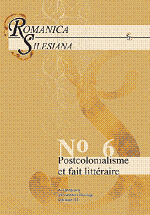L’image postcoloniale de l’Amérique du Sud dans "Saltimbanques", "Kaléidoscope brisé" et "Le Magicien" de Sergio Kokis
Postcolonial Image of South America in "Saltimbanques", "Kaléidoscope brisé" and "Le Magicien" by Sergio Kokis
Author(s): Anna ŻurawskaSubject(s): Literary Texts
Published by: Wydawnictwo Uniwersytetu Śląskiego
Keywords: Journey; cultural imperialism; colonizer/colonized relationship
Summary/Abstract: This paper attempts to examine the postcolonial image of South America in the trilogy by Sergio Kokis, composed of Saltimbanques, Kaléidoscope brisé and Le Magicien. The three novels focus on adventures of the Circus Alberti which leaves Europe, ravaged by the Second World War, in order to find a better life in South America. A travelling company of performers covers the route of the first colonizers. The journey of the circus artists allows Kokis to unmask political and social consequences of the colonization of South America, such as slavery in the plantations of yerba maté, the poverty of indigenous populations, the authoritarian power of generalissimos, the policy of terror and tortures, fratricidal conflicts, etc. The aim of the article is also to investigate a very complicated relationship between the colonizers and the colonized presented in the three novels.
Journal: Romanica Silesiana
- Issue Year: 2011
- Issue No: 6
- Page Range: 342-358
- Page Count: 17
- Language: French

